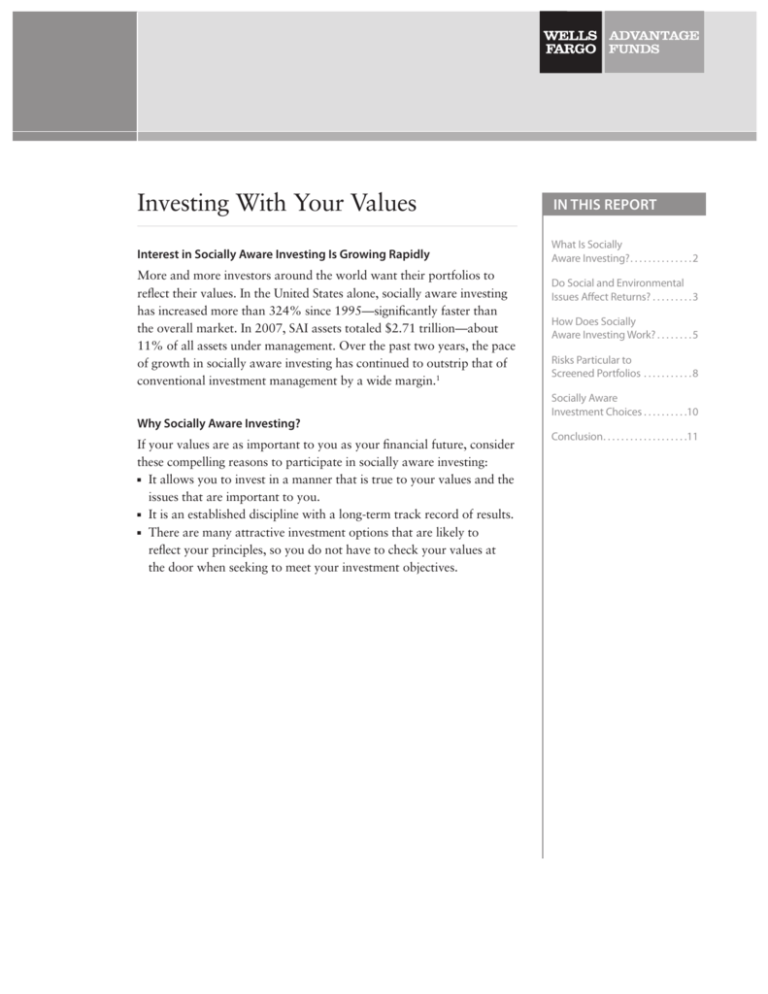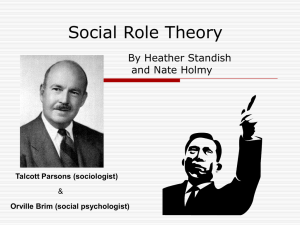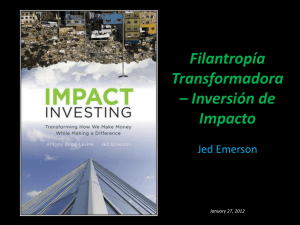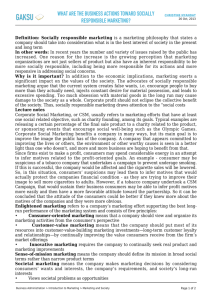
Investing With Your Values
IN THIS REPORT
Interest in Socially Aware Investing Is Growing Rapidly
What Is Socially
Aware Investing? . . . . . . . . . . . . . 2
More and more investors around the world want their portfolios to
reflect their values. In the United States alone, socially aware investing
has increased more than 324% since 1995—significantly faster than
the overall market. In 2007, SAI assets totaled $2.71 trillion—about
11% of all assets under management. Over the past two years, the pace
of growth in socially aware investing has continued to outstrip that of
conventional investment management by a wide margin.1
Why Socially Aware Investing?
If your values are as important to you as your financial future, consider
these compelling reasons to participate in socially aware investing:
It allows you to invest in a manner that is true to your values and the issues that are important to you.
It is an established discipline with a long-term track record of results.
There are many attractive investment options that are likely to reflect your principles, so you do not have to check your values at the door when seeking to meet your investment objectives.
n
n
n
Do Social and Environmental
Issues Affect Returns? . . . . . . . . . 3
How Does Socially
Aware Investing Work? . . . . . . . 5
Risks Particular to
Screened Portfolios . . . . . . . . . . . 8
Socially Aware
Investment Choices . . . . . . . . . 10
Conclusion . . . . . . . . . . . . . . . . . . 11
WHAT IS SOCIALLY AWARE INVESTING?
DO SOCIAL AND ENVIRONMENTAL ISSUES AFFEC T RETURNS?
Socially aware investing (SAI) enables
individuals and institutions to put their money
to work in a manner that is consistent with their
values and societal concerns. As with any other
investment approach, socially aware investors
choose investments based on their return and
risk potential. In addition to considering risk
and return, however, socially aware investors
take social or ethical criteria into account
when deciding whether to buy, sell, or hold
certain securities. These investors take into
consideration company policies and practices
around issues that are important to them—for
example, environmental protection or product
safety. In this manner, investors are able to invest
in companies whose philosophies and activities
are compatible with their own principles.
You may assume that socially aware investing
hurts portfolio performance. However, research
shows that socially aware portfolios have the
potential to offer competitive returns relative to
their non-SAI peers, as long as they are properly
diversified and managed with an awareness of the
impacts of the social investment criteria (screens).
Last year, researchers at Lehigh University
compared the returns of four groups of
portfolios, which use KLD Research & Analytics
social screens, to the returns of the Russell
3000 U.S. stock index. The authors concluded
that there were no significant differences in
the returns of the screened portfolios over the
1991 to 2004 time period under study. “There
is no cost to being good by investing according
to [SAI] screens. In other words, investors are
no worse off investing in accordance with their
social beliefs.”3
Most studies covering long time periods show
that social investors have done as well, on
average, as conventional investors. For instance,
a study that examined the performance of 103
U.K., German, and U.S. SAI-screened mutual
funds from 1990 to 2001 found no difference
in risk-adjusted returns between mutual funds
that screen their holdings based on SAI criteria
and unscreened mutual funds. The authors also
found that screened portfolios that have been in
existence longer appear to perform better than
younger ones.2 This conclusion underscores the
importance of working with portfolio managers
who have experience running socially aware
investment portfolios.
Another study that looked at the returns of
SAI-screened bond mutual funds for the period
of 1987 to 2003 found that their returns were
competitive with or even slightly higher than
those of their unscreened counterparts.4
1. Social Investment Forum, 2007 Report on Socially Responsible Investing Trends in the United States, 2008.
2. Oxford Handbook of Corporate Social Responsibility, Rob Bauer, Kees Koedijk, and Roger Otten, “International Evidence on Ethical Mutual Fund Performance and Investment Style,” January 2002.
3. Anne-Marie Anderson and David H. Myers, Lehigh University, “Performance and Predictability of Social Screens,” June 26, 2007.
4. Oxford Handbook of Corporate Social Responsibility, Jeroen Derwall and Kees Koedijk, “Socially Responsible Fixed-Income Funds,” working paper, Erasmus University, January 2006.
2
3
HOW DOES SOCIALLY AWARE INVESTING WORK?
who screen stocks based on human-resource
criteria may be compensated with higher
returns. Indeed, a recent study that covered the
1998 to 2005 time period supports that idea.
The study found that, even after adjusting
for factors such as the size of the company,
stocks that were on Fortune magazine’s list
of the “100 Best Companies to Work For” in
America had better returns than the overall
stock market.8
Moreover, SAI strategies that focus on certain
areas or issues have an increased potential to
outperform. These areas include:
■■
Governance. Corporate governance—how
senior managers and boards of directors run
their companies—is critically important to
all investors. One recent study found that
companies that received high governance
scores outperformed those with low scores
over three-, five-, and ten-year periods.5
Another study showed that firms with superior
corporate governance policies notably
outperformed those with weak governance in
the decade of the 1990s.6
■■
Also worthy of note is the case of the
California Public Employees Retirement
System (CalPERS). CalPERS places some of
the companies in which it invests—those most
in need of improved corporate governance—
on a focus list. CalPERS engages these firms
in dialogue with the goal of improving their
governance practices, especially in the areas of
discipline, independence, accountability, and
transparency. A study that covered the 1992
to 2005 time period found that, on average,
when CalPERS announced the addition of a
company to the focus list, the stock of that
company rose 0.23% in the day following the
announcement. This seemingly small stock
price rise increased shareholder wealth by
almost $3.1 billion over those 14 years.7
■■
Environment. Several studies support
the notion that companies that manage
environmental risks most effectively tend to
generate higher returns than their industry
peers. For example, an Erasmus University
study, which covered the 1995 to 2003 time
period, concluded that stocks of companies
with high environmental ratings markedly
outperformed poorly rated ones during
the period under study.9 Perhaps good
environmental management is an indicator
of good corporate management and can help
reduce the risk of profit disappointments due
to environmental problems.
These examples suggest that the stock market
has not fully appreciated the financial benefits
earned by companies with superior employee
relations, governance, and environmental
policies. It is possible that such companies
could potentially enjoy higher returns than their
peers over time. However, it is important to
remember that other issues of concern to social
investors may have a neutral or even negative
effect on performance. For that reason, we agree
with the mainstream of performance studies,
which indicate that socially aware investing has
generated competitive returns.
Employee Relations. Employees matter to
business performance. Yet the human resource
policies and practices of many companies are
not widely followed by the general investment
community. So it is no surprise that investors
Some investors, notably institutions in Europe,
find the use of negative screening too restrictive
from a financial standpoint. These investors
have begun to adopt a “best-in-class” social
investment approach. As an example, many
companies in the oil and gas industry face
environmental challenges—so much so that
some environmental investors exclude them
all. This would have been a potentially costly
decision in recent years, as many energy stocks
have been excellent performers relative to the
overall stock market. Instead of excluding
all traditional energy companies, a best-inclass investor would try to identify superior
environmental performers within the group and
invest in those.
Everybody’s values are different. Therefore, you
can typically decide the ways and degrees to
which you want to implement socially aware
investing in your portfolio.
Two Approaches to Socially Aware Investing:
Negative Versus Positive Screens
Socially aware investing has been traditionally
associated with negative screening. Negative
screening excludes companies or industries
whose business policies and/or practices do not
meet the investors’ SAI criteria. For example,
if you are concerned about the environment,
you may choose to screen out companies whose
practices you consider to be harmful to the
environment. While this approach can exclude
from a portfolio any company or industry that
does not meet strict criteria on all levels, for
some socially aware investors, it can prove too
restrictive.
There are many tools to help ensure that your
portfolio reflects your values. Which tools you
use will depend on how much emphasis you
wish to place on positive versus negative factors
and how stringent you wish your screening
approach to be.
As an answer to those investors who would
prefer to be proactive rather than reactive, in
recent years, the SAI field has shifted toward
positive screening. Instead of just eliminating
objectionable companies, a social investor using
positive screening might seek to proactively
include companies that show positive traits in
the areas of concern. For instance, if you are
concerned about the environment, you may use
positive screens to select alternative energy or
environmental remediation companies in your
portfolio. More broadly, positive screening may
identify lists of superior performers in various
social areas, such as the “100 Best Companies
to Work For” in America, or companies with
superior corporate governance.
The solutions are as diverse as social investors
themselves. Some apply just one or two simple
exclusionary SAI screens, while others seek out
more complex social investment programs that
involve multitiered analysis of diverse issues. In
either case, whenever possible, companies that
do not meet the investor’s standards should
be replaced with comparable, fundamentally
attractive companies that do adhere to
the investor’s financial and values-based
investment criteria.
5.Oxford Handbook of Corporate Social Responsibility, Lawrence D. Brown and Marcus L. Caylor, “The Correlation Between Corporate Governance and Company Performance,” Institutional Shareholder Services, 2004.
6. Paul Gompers, Joy L. Ishii, and Andrew Metrick, “Corporate Governance and Equity Prices,” working paper #8449, National Bureau of Economic Research, 2001.
7. Brad M. Barber, U.C. Davis, “Monitoring the Monitor: Evaluating CalPERS’ Activism,” November 2006.
8. Oxford Handbook of Corporate Social Responsibility, Alex Edmans, “Does the Stock Market Fully Value Intangibles? Employee Satisfaction and Equity Prices,” working paper, Massachusetts Institute of Technology, 2007.
9. Oxford Handbook of Corporate Social Responsibility, Jeroen, Derwall, Nadja Gunster, Rob Bauer, and Kees Koedijk, “The Eco-Efficiency Premium Puzzle,” .Financial Analysts Journal, March 2005.
4
5
Social Awareness Investment Trends
■■
The first socially aware investors were, for the
most part, motivated by religious concerns.
As a result, their emphasis was primarily
on excluding a relatively small group of
alcohol, tobacco, and gambling companies
(the so-called “sin stocks”). Over the past
several years, however, the numbers of styles,
coverage, and asset classes within SAI have
expanded dramatically.
Different geographical areas tend to trend
culturally toward one particular approach
over another. For example, in Europe, the
“sustainability” model, using best-in-class
techniques, has taken precedence and accounts
for a large and growing slice of assets under
management. In Asia, trends vary widely across
the region. The largest concentration of assets
in more developed markets, such as Australia,
focus on ethical portfolios, green loans, and
community finance but address environmental
concerns to a lesser degree than in the United
States and Europe. In developing Asian countries
such as Malaysia, Indonesia, and Singapore, the
preponderance of investment interest is in faithbased funds.
■■
■■
In the United States, the consensus leaders in
the mutual fund market have all moved their
screening process toward a more progressive/
sustainable approach. This reflects a more
mainstream interest in social investing, driven
both by changes in the makeup of society and
news events in recent years. We have seen a
particular increase in interest in three areas:
Corporate Governance. The corporate
governance failures of the early 2000s were
front-page news and resulted in significantly
heightened awareness of these issues, as well
as specific legislation (for example, SarbanesOxley) to address these concerns. Following
the scandals at Enron, WorldCom, and
elsewhere, ethicists such as Lynne Sharp Paine
at the Harvard Business School have argued
that society’s expectations for corporate
behavior have permanently risen.10 And, as we
have seen, there is some evidence that suggests
that paying attention to corporate governance
could be beneficial for investment returns.
Alternative Energy. The surge in the price of
energy this decade has created an enormous
subsidy for alternative energy, and the field is
attracting significant new investment flows.
Famous energy entrepreneur T. Boone Pickens
recently announced an initiative intended to
popularize wind power in the south-central
United States.
Stakeholder Issues. There is a growing
consensus that good corporate management
includes taking into consideration a variety
of stakeholders, in addition to shareholders.
A myopic focus on shareholders may be
financially beneficial over the short term.
However, many corporate management
teams have learned that short-term gains may
come at the cost of problems in the future.
For instance, several large U.S. retailers
have found it difficult to open new stores in
desirable communities because of reputational
problems. The shareholders in these firms have
a right to ask whether the financial benefits
accrued were worth the negative impact on
future growth.
Other social investment strategies include:
■■
■■
Community Investing. This strategy
involves investments in community
development financial institutions, which
offer disadvantaged communities access to
banking services and capital that they might
otherwise not have. These services can enable
people with low incomes to improve their
lives and enhance their communities through
new businesses, job creation, and community
betterment projects.
.Shareholder Advocacy. Certain money
managers, mutual funds, and institutional
investors—such as religious groups,
foundations, and public government funds—
also address their social concerns through
shareholder advocacy. These advocates
engage companies in dialogues to persuade
them to make improvements in specific areas
of concern.
Some of these investors also use their power as
shareholders to propose shareholder resolutions
on certain issues, actively vote their proxies
in favor of such resolutions, and take other
related actions. From 2005 through mid-2007,
185 U.S.-based money managers, institutional
investors, and mutual funds—with $723 billion
in total assets—filed resolutions on social,
corporate governance, or environmental issues.11
10. Lynn Sharp Paine, Value Shift: Why Companies Must Merge Social and Financial Imperatives to Achieve Superior Performance, 2004.
11. Social Investment Forum, 2007 Report on Socially Responsible Investing Trends in the United States, 2008.
6
7
RISKS PARTICULAR TO SCREENED PORTFOLIOS
Now consider SAI indices that apply
environmental screens. Between January 2004
and May 2008, a typical SAI index might have
allocated approximately 4% less to the energy
sector than a comparable non-SAI index.
However, during that time period, energy
stocks generally performed better than the
overall stock market. As Figure 1 illustrates,
during that period of time, the Russell 1000
Integrated Oil Index beat the total Russell 1000
Index by approximately 130%. As a result,
underweighting the energy sector negatively
affected the SAI index performance relative
to that of the conventional index. However,
carefully managing sector allocations could
have mitigated or potentially reduced this
source of underperformance. Managers of
actively managed, socially screened portfolios
can address this type of risk by bringing the
weighting of the energy sector in line with the
broader market index.
To be successful, chess players must understand
the risks they encounter and evaluate the most
likely outcome of alternative moves. The same
strategy applies to managing SAI portfolios,
as they represent different sets of economic
opportunities from those of more broadly
based market indices. To achieve competitive
returns, it is critical that your portfolio manager
understands and properly manages the risks
of your SAI portfolio. For instance, excluding
securities or sectors from a portfolio can change
its risk profile by altering certain characteristics—
such as market capitalization, growth/value tilt,
and exposure to economic sectors—which could
affect the portfolio’s performance relative to
conventional benchmark indices.
Consider a portfolio that avoids investing
in companies that are involved in alcohol,
gambling, and tobacco. It will typically have a
smaller allocation to the industrials and basic
materials sectors than conventional portfolios
and thus have a larger allocation to financial,
consumer cyclical, technology, and health care
industries. As a result, the portfolio could have
a greater tilt toward growth-style securities
than its nonscreened counterparts. Unless the
portfolio manager adjusts the sector allocation
to be more style neutral, this screened portfolio
could likely perform better than comparable
nonscreened portfolios when growth sectors
are doing well but underperform when growth
sectors are out of favor.
8
Figure 1
Figure 2
Energy Stocks Have Recently Outperformed the Overall Stock Market
Total Russell 1000 Index vs. Russell 1000 Integrated Oil Index
January 2004 to June 2008
The Automobile Sector Has Recently Underperformed the Overall Stock Market
Total S&P 500 Index vs. Its Automobile Manufacturing Segments
December 31, 2001, to June 30, 2008
150%
50%
Russell 1000 Index
130%
40%
Russell 1000 Integrated Oil Index
S&P 500 Automobile and Components Index
S&P 500 Index
30%
110%
20%
90%
10%
70%
0%
50%
-10%
30%
-20%
10%
-30%
-10%
-30%
Dec 03
-40%
-50%
Jun 04
Dec 04
Jun 05
Dec 05
Jun 06
Dec 06
Jun 07
Dec 07
Dec 01 Jun 02 Dec 02 Jun 03 Dec 03 Jun 04 Dec 04 Jun 05 Dec 05 Jun 06 Dec 06 Jun 07 Dec 07 Jun 08
Jun 08
Source: Bloomberg, 6-8-08
Source: Bloomberg, 6-8-08
Past performance is no guarantee of future returns.
Past performance is no guarantee of future returns.
Although some of the sectors that are typically
excluded from screened portfolios can
outperform or underperform the broad stock
market, you as a social investor could potentially
profit from excluding certain industries. For
instance, as Figure 2 shows, between December
31, 2001, and June 30, 2008, the automobile
sector of the S&P 500 Index—which is often
underweighted in SAI portfolios—had a lower
return than the total S&P 500 Index. So by
having a smaller allocation to the automobile
segment than did the total S&P 500 Index,
screened portfolios possibly could have enjoyed
higher returns than the total S&P 500 Index
during that period.
We strongly believe that SAI investors and their
portfolio managers must carefully monitor and
control these kinds of risks to avoid unintended
bets and achieve consistent and competitive
returns. To that end, your portfolio manager
should carefully identify the securities to be
excluded from your SAI portfolio and offset the
gap created by the exclusion of those securities.
Ultimately, socially aware investing is not
without risks or challenges. However, if done
properly, socially aware investing can deliver
competitive returns and allow you to own
attractive securities that are consistent with
your values.
9
SOCIALLY AWARE INVESTMENT CHOICES
Socially aware investing is flourishing as more
and more investors want their investments to
be consistent with their principles and societal
concerns. Today, you have more options
than ever before to help you maintain a welldiversified portfolio that truly reflects your
personal values.
■■
Figure 3
If you wish to participate in shareholder
advocacy, there are some money managers and
mutual funds that engage in this SAI strategy.
Please consult with your investment professional
to determine which socially aware investment
options are appropriate for you. We urge you
to consider your socially aware investments in
the context of your entire portfolio. Work with
your investment professional to ensure that
your portfolio, as a whole, is suitable for your
financial circumstances and goals, adequately
diversified, likely to meet your return objectives,
and consistent with your level of risk tolerance
and other investment constraints.
Mutual Funds. In the United States alone, there
were about 154 socially aware mutual funds
in 2007. These mutual funds cater to investors
with a wide range of political backgrounds
and social concerns. As Figure 3 shows, there
are socially screened products for just about
any set of values.12
Socially aware investing is a respected discipline
in which interest is growing rapidly around
the world. Investors are increasingly concerned
about social, environmental, and ethical
issues that affect our world, and corporations
are responding. As a result, today, nearly
one of every nine dollars under professional
management in the United States is invested
using social and environmental criteria.13
There Are Socially Screened Products for Just About Any Set of Values
Social Screening by All Funds, 2007
$174.1
Tobacco
Alcohol
$158.1
Labor
If an SMA is not appropriate for you, there are
plenty of other options. These include:
■■
Closed-End Funds. These are investment
companies that issue a fixed number of shares.
The shares are listed on a stock exchange and
traded in the secondary market. The assets
in these funds can be invested by the fund
manager in stocks, bonds, and other securities.
If you are interested in community investing,
you can place capital directly in community
development banks, community development
credit unions, and community development loan
funds. Alternatively, you can invest in investment
products that spread investors’ capital across
these institutions.
Customized options are available to wealthier
investors through socially screened separately
managed accounts (SMAs). This type of account
can be tailored to your investment needs and
personal values. If you have an SMA, you can
work with your portfolio manager to develop
and apply specific social and environmental
criteria so that your portfolio is consistent
with your societal, religious, and ethical goals.
Separately managed accounts typically require a
high minimum initial investment, however, and
you are likely to need a large amount of money
to invest in order to maintain an adequately
diversified portfolio.
■■
Conclusion
$48.1
$44.5
Environment
Defense/Weapons
$42.2
Community Relations
$41.8
Gambling
$41.2
Products/Services
$38.6
EEO/Equality
$34.0
Human Rights
Corporate Governance
$30.0
$21.1
Pornography
$18.3
Faith-Based
$17.7
Abortion
$14.5
Animal Testing
$14.1
Sudan
Other*
$0
The swift growth in socially aware investing
is also a result of the fact that portfolio
managers have proven that SAI portfolios offer
potential for competitive returns that is similar
to conventional investing. Studies that have
analyzed the performance of SAI portfolios over
long periods of time have shown that socially
aware investors have done as well, on average,
as conventional investors.
We believe that the best way to participate
in socially aware investing is to select an
experienced portfolio manager or fund that
has a recognized track record in successfully
navigating the risks specific to this investment
style. There are many competitive SAI
investment options to match your unique values
and social concerns. We are confident that if you
choose socially aware investing, you will have
the satisfaction of knowing that your money is
being put to work in a manner that reflects your
core values and helps you achieve your longterm financial goals.
$12.1
$10.0
$25
$50
$75
$100
$125
$150
$175
$200
Total Net Assets ($ Billions)
Source: Bloomberg, 6-8-08
Past performance is no guarantee of future returns.
Source: Social Investment Forum, 2007 Report on Socially Responsible
Investing Trends in the United States, July 2008.
*Among the “other” screens used are issues such as “anti-family”
entertainment and “alternative lifestyles,” health care, public health,
biotechnology, medical ethics, cultural concerns, corporate charitable and
political contributions, youth concerns, and terrorist states.
Exchange-Traded Funds. There are several
socially screened exchange-traded funds
(ETFs). These ETFs replicate the securities
held by a particular socially aware investment
index and can be traded on a stock exchange
as if they were stocks.
12. As measured by total net assets under management. Source: Social Investment Forum, 2007 Report on Socially Responsible Investing Trends in the
United States, 2008.
10
13. Social Investment Forum, 2007 Report on Socially Responsible Investing Trends in the United States, 2008.
11
Stock fund values fluctuate in response to the activities of individual
companies and general market and economic conditions. Bond fund
values fluctuate in response to the financial condition of individual issuers,
general market and economic conditions, and changes in interest rates. In
general, when interest rates rise, bond fund values fall and investors may
lose principal value. Some funds, including nondiversified funds and funds
investing in foreign investments, high-yield bonds, small and mid cap stocks,
and/or more volatile segments of the economy, entail additional risk and
may not be appropriate for all investors. Consult a Fund’s prospectus for
additional information on these and other risks.
Carefully consider a fund’s investment objectives, risks, charges, and
expenses before investing. For a current prospectus, containing this and
other information, call 1-888-877-9275 or visit www.wellsfargo.com/
advantagefunds. Read it carefully before investing.
Asset allocation and diversification do not assure or guarantee better performance and cannot
eliminate the risk of investment losses.
The Russell 3000® Index measures the performance of the 3,000 largest U.S. companies based on total
market capitalization, which represents approximately 98% of the investable U.S. equity market.
The Russell 1000® Index measures the performance of the 1,000 largest companies in the Russell 3000
Index, which represents approximately 92% of the total market capitalization of the Russell 3000 Index.
The Russell 1000® Integrated Oil Index is a subset of the Russell 1000 Index; it includes those integrated
oil companies included in the Russell 1000.
The S&P 500 Index consists of 500 stocks chosen for market size, liquidity, and industry group
representation. It is a market-value weighted index, with each stock’s weight in the index
proportionate to its market value.
The S&P 500 Industry Multi-Utilities Index is a capitalization-weighted index calculated on a total
return basis with dividends reinvested. It is a subset of the S&P 500; it includes those multi-utilities
companies included in the S&P 500 Index.
The S&P 500 Sub-Industry Automobile Manufacturers Index is a capitalization-weighted index
calculated on a total return basis with dividends reinvested. It is a subset of the S&P 500; it includes
those automobile manufacturers included in the S&P 500 Index.
More information about Wells Fargo Advantage Funds®
is available free upon request. To obtain literature,
please write, e-mail, or call:
Wells Fargo Advantage Funds
P.O. Box 8266
Boston, MA 02266-8266
E-mail: wfaf@wellsfargo.com
Investment Professionals: 1-888-877-9275
Web site: www.wellsfargo.com/advantagefunds
You cannot invest directly in an index.
Wells Fargo Funds Management, LLC, a wholly owned subsidiary
of Wells Fargo & Company, provides investment advisory and
administrative services for Wells Fargo Managed Account Services
and Wells Fargo Advantage Funds. Other affiliates of Wells Fargo &
Company provide subadvisory and other services for the Funds. The
Funds are distributed by Wells Fargo Funds Distributor, LLC, Member
FINRA/SIPC, an affiliate of Wells Fargo & Company. 112247 10-08
© 2008 Wells Fargo Funds Management, LLC. All rights reserved.
www.wellsfargo.com/advantagefunds
100%
Cert no. XX-XXX-XXXXXX
Printed with soy ink
FAWP0013 10-08






